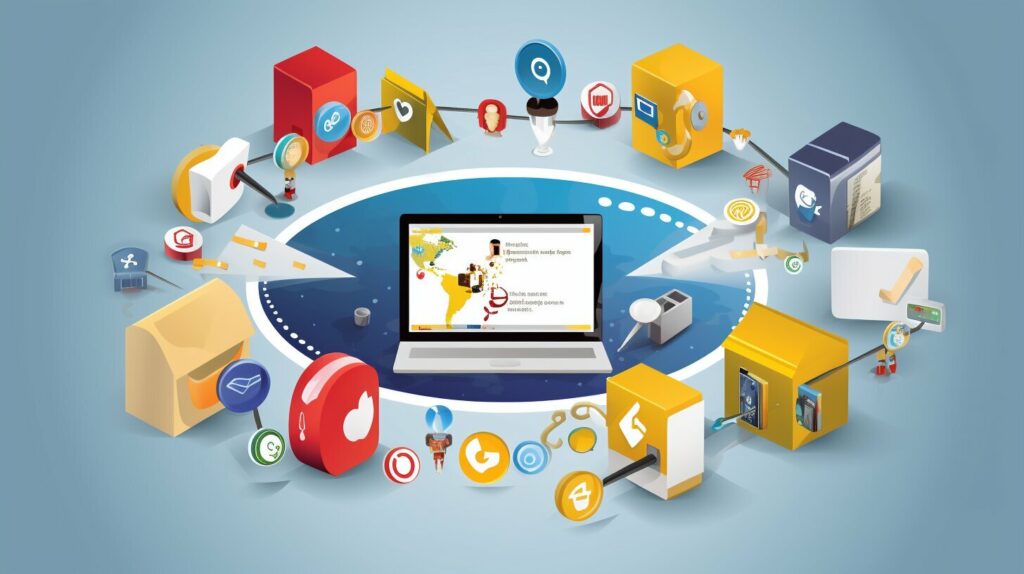Email marketing is a powerful tool that can significantly boost your business growth when executed with effective strategies and techniques. It allows you to directly reach your target audience, nurture relationships, and drive conversions. To harness the full potential of email marketing, it’s essential to implement a comprehensive strategy that covers every aspect of this dynamic marketing channel.
Section 1 of this article explores the concept of email marketing and highlights the importance of using effective strategies to achieve success. It delves into the various components of email marketing, including email campaigns, automation, newsletters, software, delivery, analytics, segmentation, conversion, and overall strategy. By understanding these key elements and implementing the right tactics, you can unlock the true power of email marketing.
Key Takeaways:
- Email marketing is a powerful tool for business growth.
- Effective strategies and techniques are essential for success.
- Email campaigns, automation, newsletters, software, delivery, analytics, segmentation, conversion, and overall strategy are crucial components of email marketing.
Stay tuned for the upcoming sections of this article, where we will dive deeper into each component and provide practical tips for optimizing your email marketing efforts. With the right strategies in place, you can unlock success and achieve your business goals through email marketing.
Building a Clean and Segmented Email List
Building a clean and segmented email list is the foundation of successful email marketing. By ensuring that your list consists of engaged and interested recipients, you can maximize the effectiveness of your email campaigns. It all starts with obtaining permission from your subscribers, which not only ensures compliance with anti-spam regulations but also establishes a trusting relationship with your audience.
To maintain a clean list, it’s crucial to regularly clean out inactive or generic email addresses. Inactive subscribers can negatively impact your email deliverability and engagement rates. By identifying and removing these addresses, you can focus your efforts on those who are genuinely interested in your content.
Segmentation is also key to email marketing success. By dividing your email list into smaller segments based on demographics, interests, or behavior, you can tailor your messages to resonate with each specific group. This level of personalization enhances engagement and increases the chances of conversions. For example, if you’re a clothing retailer, segmenting your list based on gender and past purchases allows you to send targeted offers to each segment, increasing the likelihood of a sale.

| List cleaning benefits | Segmentation benefits |
|---|---|
| Improved deliverability | Higher open and click-through rates |
| Reduced bounce rates | Increased engagement and conversions |
| Enhanced sender reputation | Personalized and relevant content |
Best Practices for Building and Maintaining your Email List
- Obtain explicit permission from subscribers through opt-in forms or double opt-ins.
- Regularly clean out inactive or generic email addresses from your list.
- Segment your list based on demographics, interests, or behavior.
- Send targeted and personalized content to each segment.
- Monitor email engagement metrics to identify inactive subscribers.
Remember, a clean and segmented email list ensures that your messages reach the right people at the right time. By focusing on permission, cleaning, and segmentation, you can unlock the full potential of your email marketing campaigns.
Crafting Compelling Subject Lines
A well-crafted subject line is essential in grabbing the attention of your recipients and increasing open rates. With the average person receiving dozens of emails each day, it’s crucial to make your email stand out from the crowd. By utilizing personalization, mobile optimization, and engaging preheaders, you can create subject lines that compel readers to click and explore your message.
Personalization is key when it comes to subject lines. Including the recipient’s name or other relevant information can make the email feel more personalized and increase the likelihood of it being opened. Additionally, mobile optimization is vital in today’s digital landscape. With the majority of emails being read on mobile devices, it’s important to ensure that your subject line is both visually appealing and easily readable on smaller screens.
Another effective technique is to utilize engaging preheaders. These are the short snippets of text that appear right after the subject line in the preview. By crafting a compelling preheader, you can provide a teaser of what’s inside the email and entice recipients to open it. Whether it’s a special offer, a time-limited promotion, or an intriguing question, a well-crafted preheader can make all the difference in encouraging email engagement.
Subject Line Examples
| Subject Line | Description |
|---|---|
| Hey [Recipient’s Name], check out this exclusive offer just for you! | Personalized subject line that makes the recipient feel special and entices them to open the email. |
| Get 50% off your favorite products – limited time only! | An urgent and time-limited offer that creates a sense of urgency and encourages recipients to take action. |
| Don’t miss out on our latest updates and exclusive content! | A promise of valuable and exclusive content that piques the recipient’s curiosity and encourages them to open the email. |
Remember, the subject line is your first opportunity to make a positive impression on your recipients. By incorporating personalization, mobile optimization, and engaging preheaders, you can increase the likelihood of your emails being opened and read. Experiment with different techniques, analyze your data, and refine your subject lines for maximum impact.

“A compelling subject line is like a key that unlocks the door to your email, enticing recipients to open and explore what’s inside.”
With the right subject line, you can capture your audience’s attention, increase open rates, and ultimately drive success in your email marketing campaigns. The next section will delve into the importance of engaging content and how it contributes to the overall effectiveness of your emails.
Engaging Content
Engaging content is the key to retaining readers’ interest and increasing the effectiveness of your email campaigns. When crafting your email content, it’s important to focus on personalization, visual appeal, and conciseness.
Personalization is a powerful tool that allows you to speak directly to your audience, making them feel valued and understood. By segmenting your email list and tailoring your content to each group, you can deliver relevant messages that resonate with your recipients. A study by Campaign Monitor found that personalized emails generate a 26% higher open rate compared to generic ones, highlighting the impact of personalization on engagement.
Visual appeal is another crucial aspect of engaging content. A visually appealing email design with eye-catching images, colors, and fonts can grab your readers’ attention and entice them to explore further. However, it’s important to strike the right balance and not overwhelm your audience with excessive visuals. Keep it clean and professional, ensuring that the design elements complement your message rather than distract from it.
Conciseness is key when it comes to email content. Attention spans are short, and people are often scanning their inbox for important information. Make your message clear and concise, getting straight to the point. Use bullet points or numbered lists to break up the text and make it easier to digest. According to a study by Litmus, emails with a reading time of 2 minutes or less have the highest click-through rates, reinforcing the importance of concise messaging.
Effective Strategies for Engaging Content
To optimize your email content for engagement, consider implementing the following strategies:
- Use storytelling techniques to connect with your audience emotionally and make your message more memorable.
- Incorporate dynamic content that adapts to each recipient’s preferences and behavior, creating a personalized experience.
- Add social proof, such as customer testimonials or reviews, to build trust and credibility.
Remember to regularly analyze the performance of your email campaigns and make data-driven decisions to continually improve your engagement rates. By focusing on delivering engaging content that resonates with your audience, you can unlock the full potential of your email marketing efforts.
| Engaging Content Checklist |
|---|
| ✓ Personalize your emails for each recipient segment. |
| ✓ Create visually appealing designs that complement your message. |
| ✓ Keep your content concise and easy to read. |
| ✓ Incorporate storytelling, dynamic content, and social proof. |

Driving Action with Clear Call-to-Actions
Driving action is crucial in converting email recipients into customers, and clear call-to-actions can significantly impact the success of your campaigns. A call-to-action (CTA) is a prompt that encourages your readers to take a specific action, such as making a purchase, subscribing to a newsletter, or downloading a free resource.
When creating your CTAs, timing is everything. You want to strike the right balance between being persistent and not overwhelming your readers. Place your CTAs strategically throughout your email, making sure they are easily visible and stand out from the rest of the content. Experiment with different placements to determine what works best for your audience.
To maximize engagement, use concise and action-oriented language in your CTAs. Instead of generic phrases like “Click here” or “Learn more,” try using more compelling and specific language, such as “Get your free e-book now” or “Unlock exclusive discounts today.” This will create a sense of urgency and entice readers to take immediate action.
The Power of Visuals
Visual elements can also play a crucial role in driving action. Including relevant images or videos in your email can capture the attention of your readers and make your CTAs more compelling. For example, if you’re promoting a new product, include a high-quality product image that showcases its features and benefits.
Additionally, you can use graphics or buttons to make your CTAs more visually appealing. Design them in a way that stands out from the rest of the content and clearly communicates the desired action. Experiment with different colors, shapes, and sizes to find what resonates best with your audience.
| Key Elements for Effective CTAs | Examples |
|---|---|
| Clear and concise language | “Shop Now,” “Get Started,” “Claim Your Discount” |
| Eye-catching design | Use contrasting colors, bold fonts, and appropriate sizing |
| Placement | Strategically place CTAs throughout your email, ensuring they are easily visible |
| Relevance | Align your CTAs with the content of your email and the recipient’s interests |
Remember to track the performance of your CTAs and analyze the data to optimize future campaigns. Pay attention to click-through rates, conversion rates, and the overall engagement generated by your CTAs. This data will provide valuable insights into what resonates with your audience and what changes you can make to improve your results.
By crafting clear and compelling call-to-actions, you can drive action and increase the effectiveness of your email marketing campaigns. Don’t underestimate the power of a well-designed CTA in turning your email recipients into loyal customers.
Integrating your email campaigns with other marketing strategies and channels can create a powerful synergy and maximize the effectiveness of your overall marketing efforts. By combining email marketing with social media, content marketing, and other advertising channels, you can reach a wider audience and engage with your customers on multiple platforms.
One way to integrate your email campaigns with other marketing strategies is by promoting your social media channels in your email newsletters. Include social media icons and encourage your subscribers to follow your brand for updates, promotions, and exclusive content. This not only helps increase your social media following, but also allows you to establish a stronger online presence and build a community around your brand.
In addition to social media integration, consider incorporating your email campaigns into your content marketing strategy. Include links to your blog posts, articles, or videos in your emails to drive traffic and encourage engagement. By providing valuable and relevant content to your subscribers, you establish yourself as an authority in your industry and build credibility.
Furthermore, don’t forget to leverage other advertising channels to promote your email campaigns. This can include running targeted ads on search engines, social media platforms, or partnering with influencers to reach your target audience. By incorporating email marketing into your overall advertising strategy, you can ensure consistent messaging and maximize your brand exposure.

Integrating your email campaigns with other marketing strategies and channels offers several benefits. First and foremost, it allows you to reach a larger audience and increase brand exposure. By leveraging the power of different marketing channels, you can extend your reach and attract new customers.
Secondly, integration enhances the effectiveness of your campaigns. By using a multi-channel approach, you can reinforce your messaging and increase the chances of capturing your audience’s attention. Different channels have different strengths, and by combining them, you can create a more comprehensive marketing strategy.
Lastly, integrating your email campaigns with other marketing strategies provides valuable insights and data. By tracking the performance of your campaigns across different channels, you can gain a deeper understanding of your audience’s preferences and behavior. This data can then be used to refine and optimize your marketing efforts for better results.
| Benefits of Integration | |
|---|---|
| Expanded reach and brand exposure | |
| Enhanced campaign effectiveness | |
| Valuable data and insights |
In conclusion, integrating your email campaigns with other marketing strategies and channels can have a significant impact on your overall marketing success. By combining the power of email marketing with social media, content marketing, and other advertising channels, you can reach a wider audience, reinforce your messaging, and gain valuable insights. So, start integrating today and unlock the full potential of your email marketing efforts.
Personalization, Optimized Design, and Email Analytics
Personalization, optimized email design, and thorough analysis of email metrics are essential components of successful email marketing. Tailoring your emails to individual recipients, designing visually appealing templates, and closely monitoring the performance of your campaigns can significantly impact your results. Let’s explore each of these components in detail.
Personalization
One of the most effective ways to engage your audience is through personalized email content. By addressing recipients by name and tailoring the message to their specific interests and preferences, you can create a strong connection and establish trust. According to a study by Accenture, 91% of consumers are more likely to shop with brands that provide relevant offers and recommendations. Personalization goes beyond just using the recipient’s name; it involves segmenting your email list based on demographics, behavior, and purchase history. This allows you to craft targeted messages and deliver the right content to the right people at the right time.
Optimized Design
In today’s mobile-first world, optimizing your email design for different devices is crucial. According to Litmus, 46% of all email opens occur on mobile devices. Therefore, it’s essential to ensure that your emails are mobile-friendly and render correctly across various screen sizes. Use responsive design techniques to create visually appealing emails that are easy to read and navigate. Incorporate eye-catching images, clear calls-to-action, and concise messaging to capture your recipients’ attention. Remember to keep your design consistent with your brand identity and provide a seamless user experience.
Email Analytics
To truly unlock the potential of your email marketing campaigns, it’s vital to analyze and interpret the data from your email metrics. Email analytics provide valuable insights into the performance of your campaigns, allowing you to understand what works and what doesn’t. By tracking key metrics such as open rates, click-through rates, and conversion rates, you can identify trends, optimize your content, and make data-driven decisions. Additionally, A/B testing can help you compare different elements, such as subject lines, call-to-actions, or email layouts, to determine the most effective strategies for your audience. Regularly reviewing your email analytics and implementing improvements based on the data will drive better engagement and ultimately, improve your email marketing success.

Automation and Segmentation for Targeted Messaging
Automation and segmentation play vital roles in delivering highly targeted and relevant messages to different customer segments, resulting in increased engagement and conversions. By automating your email marketing campaigns, you can streamline the process and save valuable time. With automated workflows, you can set up triggers based on specific customer actions or behaviors, such as a welcome series for new subscribers or a re-engagement campaign for inactive customers.
Segmentation takes personalization to the next level by dividing your email list into distinct groups based on various criteria, such as demographics, purchase history, or engagement level. This allows you to create tailored content that resonates with each segment, increasing the chances of driving meaningful interactions. For example, you can send targeted product recommendations to customers who have previously shown an interest in similar items or offer exclusive promotions to your most loyal subscribers.
| Benefits of Automation and Segmentation: |
|---|
| – Higher open and click-through rates |
| – Improved customer satisfaction and loyalty |
| – Increased conversion rates and revenue |
| – Reduced unsubscribe rates |
By leveraging automation and segmentation, you can deliver highly personalized messages that resonate with your audience, leading to more meaningful interactions and ultimately, better results. Remember to regularly analyze the performance of your email campaigns using email analytics to track key metrics such as open rates, click-through rates, and conversions. This data will provide valuable insights into the effectiveness of your messaging and help you refine your strategies for optimal outcomes.

In summary, automation and segmentation are powerful tools in your email marketing arsenal. They enable you to deliver targeted and relevant messages to different customer segments, fostering stronger connections and driving desired actions. By adopting advanced strategies such as personalization, dynamic content, and A/B testing, you can take your email marketing efforts to new heights, unlocking even greater success in reaching and engaging your audience.
Conclusion
By implementing effective email marketing strategies, you can unlock the full potential of this powerful tool and achieve remarkable success in your business growth. Building a clean and segmented email list, crafting compelling subject lines, and creating engaging content are fundamental to capturing your audience’s attention and keeping them interested. Clear call-to-actions and strategic timing will drive action and maximize engagement. Integrating email campaigns with other marketing strategies and channels will amplify their impact, reaching a wider audience and generating more leads. Personalization, optimized email design, and email analytics enable you to tailor your messages and analyze their effectiveness. Automation and segmentation further enhance your ability to deliver targeted and relevant messaging to different customer segments.
By adopting advanced strategies such as personalization, dynamic content, and A/B testing, you can take your email marketing efforts to the next level, increasing conversions and fostering lasting customer relationships.
Email marketing is a powerful tool that, when used effectively, can drive significant results. By implementing these strategies, you can position your business for success and achieve your marketing goals. Don’t miss out on the opportunity to connect with your audience, build brand loyalty, and drive revenue. Start unlocking the potential of email marketing today.
FAQ
What is email marketing?
Email marketing refers to the practice of sending targeted marketing messages to a group of individuals via email. It is a powerful tool for businesses to communicate with their audience, build relationships, and drive conversions.
Why is building a clean and segmented email list important?
Building a clean and segmented email list is crucial because it ensures that your messages are reaching the right audience. By obtaining permission from recipients and regularly cleaning out inactive or generic email addresses, you can maintain a high level of engagement and deliver personalized content.
How can I craft compelling subject lines?
Crafting compelling subject lines involves utilizing personalization, mobile optimization, and engaging preheaders. Personalization helps to grab the recipient’s attention, mobile optimization ensures your subject line is easily readable on different devices, and engaging preheaders provide a preview of the email content.
What makes engaging content in email marketing?
Engaging content in email marketing is personalized, visually appealing, and concise. Tailoring the content to the recipient’s interests, using eye-catching designs, and keeping the message concise help to captivate readers and keep them interested in your emails.
How do I drive action with clear call-to-actions?
Driving action with clear call-to-actions involves strategically placing them in your email and ensuring they are easily noticeable. Additionally, timing plays a crucial role in maximizing engagement, so consider the best moment to prompt recipients to take the desired action.
Why is integrating email campaigns with other marketing strategies important?
Integrating email campaigns with other marketing strategies and channels amplifies their impact. By coordinating your email marketing efforts with other marketing initiatives such as social media campaigns or content marketing, you can reach a wider audience and reinforce your messaging.
How does personalization, optimized design, and email analytics contribute to successful campaigns?
Personalization helps to create a tailored experience for recipients, optimized design ensures that your emails are visually appealing and readable, and email analytics provide valuable insights into your campaign’s performance. By utilizing these elements, you can improve engagement and achieve better results.
What is the role of automation and segmentation in email marketing?
Automation and segmentation play vital roles in delivering targeted and relevant messages to different customer segments. Automation allows you to send emails triggered by specific actions or events, while segmentation enables you to divide your audience into groups based on their characteristics or behavior, ensuring that each recipient receives the most relevant content.
How can advanced strategies take email marketing to the next level?
Advanced strategies such as personalization, dynamic content, and A/B testing can elevate email marketing campaigns. Personalization allows for highly targeted messages, dynamic content enables personalized and interactive experiences, and A/B testing helps optimize campaign elements for better performance.


